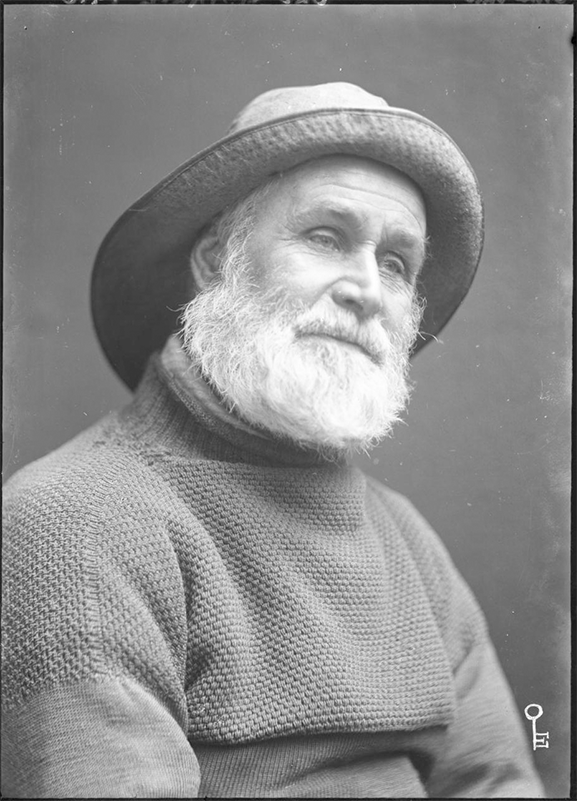James Williams
THE CRIMINAL
b. 1872 — d. 1944
North Shields, Tyneside, England

These extremely practical garments are made from tightly knitted wool, which made them warm, hardwearing and to an extent water-resistant. As such were they were popular with sailors and fishermen who wore them to resist rain and sea spray during their physically demanding work. Though guernseys are thought to have developed in the British Isles during the 15th Century, exactly where and when is unknown.



Variously patterned ganseys from Norfolk; three portraits by remarkable photographer
Mary Olive Edis.

Guernseys were designed with a square neck and patterning on both front and back so they could be reversed. This ensured that areas most exposed to wear and tear, like the chest and elbows could be alternated ensuring they lasted longer. The patterns themselves were influenced by a life at sea, taking inspiration from a range of nautical paraphernalia like nets, ropes, ladders, waves, herringbones and so on. There are hundreds of styles and designs were often unique to individual coastal towns and villages. This gave rise to the claim that, more than just decorative elements, guernseys could be used as a grisly form of identification, where if the body of a drowned sailor washed ashore and his identity couldn’t be determined then the pattern knitted into his jumper could help return him to the place from which it originated. Perhaps slightly disappointingly, there’s no factual evidence to support this and is likely to be a charming, albeit macabre maritime myth. Although certain styles would have originated in Whitby, Seahouses, Scarborough or hundreds of other towns and villages around the country, in reality patterns often migrated from place to place along with the men who wore them and so are unlikely to be an accurate means of identification.
Gansey patterns from the North Yorkshire Coast:






The witness in question was one Miss Appleby, an assistant at Mr Graham’s pawnbrokers where the theft had taken place. Williams, professing his innocence – of a sort – replied ‘I never intended stealing it or I wouldn’t have brought it here’. Presumedly ‘here’ is to the police station in the first instance, though again this isn’t clear. Despite turning himself in, the fact there was a witness and that the accused was actually in possession of the stolen property, Williams was dismissed of all charges after his employer spoke on his behalf, stating ‘that during the eight years he had been with him [the] defendant had been entrusted with thousands of pounds and nothing had gone wrong’. Nothing more than a drunken prank then, the theft and return of a jumper hanging outside a shop and taken as he passed on a whim. An inconsequential crime but one that has left behind an enigmatic portrait that still exists over 100 years later.
Other mugshots taken at the North Shields police station:



James Williams, a labourer, was charged with being drunk and disorderly and with assaulting Sergt. Jobling. The sergeant said that owing to [the] defendant’s conduct he was compelled to take him into custody. He at once struck out violently and kicked [a] witness savagely on the knee, causing much discolouration. P.C. Henderson assisted in the apprehension and Williams knocked his helmet off. [The] defendant had received no provocation, and would not be reasoned with. He behaved like a madman, and had to be chained down in the cell. P.C. Henderson and Inspector Hildreth also spoke to the violent conduct of [the] defendant. For being drunk and disorderly he was find 2s 6d and costs, and for the assault a fine of 20s and costs was imposed.
If we assume it is the same man then his behaviour appears to have improved between the two articles, which is probably just as well as Williams had a family who are likely to have depended on him. The census lists a James A. Williams, who worked as a general labourer, living at 26 Beacon Street in North Shields along with two other occupants, his wife Louisa Williams, 26, and their daughter, also called Louisa, who was 4. This is almost certainly the same larcenous Williams from the Gazette’s article, as the street he lived on and his approximate age both match. His birth year is recorded as 1872 meaning Williams would have been 29 or 30 in his police station portrait. The Williams family appear together again in the 1911 census, when James’ middle name is revealed to be Anthony and his occupation is still listed as a labourer. Beyond that there’s not much more information available about James A. Williams until the England and Wales Civil Registration of Death Index for 1944. Here a man in North Shields with the same name is recorded deceased aged 71. It appears he made a will – as registered in the Index of Wills for that year – but the beneficiary isn’t his wife or daughter who were both still alive at the time. Instead £40 and 4 shillings are made out to ‘Elsie May Taylor (wife of William Taylor)’ in Newcastle and it remains unclear as to what the connection is between them.
INFORMATION SOURCES
& FURTHER READING
– The second Shields Daily Gazette article to be mentioned from 30 April 1900 is also available through the British Newspaper Archive
– The England & Wales Census for 1901 and 1911
– England & Wales National Probate Calendar (Index of Wills and Administrations), 1858-1995
– Information via Wikipedia on the Guernsey pound coin, as well as information on guernseys/ganseys from:
– Wikipedia
– The BBC for York and North Yorkshire
– Gansey retailers Flamborough Marine
– and the in-depth blog Gansey Nation
IMAGE SOURCES
– Image 1 Police mugshot of James Williams, 24 August, 1902. Tyne & Wear Archives and Museum, via Flickr Commons
– Image 2 Photograph, glass plate negative of Old Charlie (Charlie Grice), by Mary Olive Edis c.1918. Norfolk Museums Collections
– Image 3 Photograph, platinotype of Billy Harrison, by Mary Olive Edis c. 1918. Norfolk Museums Collections
– Image 4 Photograph, platinotype of Latter Day Cox, by Mary Olive Edis c.1918. Norfolk Museums Collections
– Image 5 Fishermen with lobster pots, Sheringham, Norfolk, c 1903. National Maritime Museum Collections
– Image 6 Police mugshot of James Dawson, 1902. Tyne & Wear Archives and Museum, via Flickr Commons
– Image 7 Police mugshot of Jerome Guerrini, 1904. Tyne & Wear Archives and Museum, via Flickr Commons
– Image 8 Police mugshot of Henry Moreland, 1902. Tyne & Wear Archives and Museum, via Flickr Commons
– Image 2 Photograph, glass plate negative of Old Charlie (Charlie Grice), by Mary Olive Edis c.1918. Norfolk Museums Collections
– Image 3 Photograph, platinotype of Billy Harrison, by Mary Olive Edis c. 1918. Norfolk Museums Collections
– Image 4 Photograph, platinotype of Latter Day Cox, by Mary Olive Edis c.1918. Norfolk Museums Collections
– Image 5 Fishermen with lobster pots, Sheringham, Norfolk, c 1903. National Maritime Museum Collections
– Image 6 Police mugshot of James Dawson, 1902. Tyne & Wear Archives and Museum, via Flickr Commons
– Image 7 Police mugshot of Jerome Guerrini, 1904. Tyne & Wear Archives and Museum, via Flickr Commons
– Image 8 Police mugshot of Henry Moreland, 1902. Tyne & Wear Archives and Museum, via Flickr Commons

